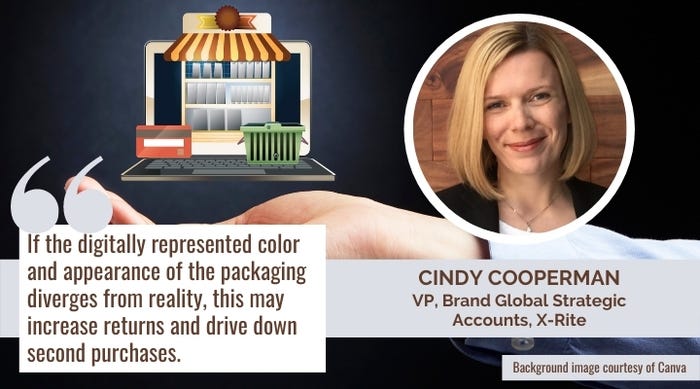How Will Digital Shopping Change Packaging Design?
Consumer recognition of your brand and/or product — which is critical to sales — will depend on how well your physical and digital personas match.

Online retailers see global consumer spending up $900 billion compared to the previous two-year trend data, according to the Mastercard Economics Institute. While many retailers benefited from online sales during the pandemic, grocery and discount stores are the most likely candidates to benefit from a dramatic and lasting shift to ecommerce.
In the past, online sales drove a small portion of overall sales for grocery and discount retailers. But that all changed during the pandemic as many consumers turned to online grocery shopping platforms, such as InstaCart, PeaPod, FreshDirect, and Amazon.
According to the Mastercard report, online grocery sales grew from 7% to 9% during the pandemic. While only a single-digit share, it represents noticeable growth in a segment that previously had comparatively lower digital sales. The good news is that grocers will likely retain approximately 70% to 80% of the digital sales growth they experienced at the peak of the pandemic.
Packaging for ecommerce sales relies on “visualization.”
From a consumer goods perspective, brand managers now need to consider the role color and packaging play in product recognition on the “ecommerce shelf.” What are the branding opportunities and challenges when grocery, cleaning, or personal care items move to the digital world? Will consumers be able to find and interact with their favorite brands in the same way?
Brand and packaging designers know that color plays a crucial role in product recognition on the shelf and online. In a retail environment, there is a “wall of color.” This refers to a brand’s visual presence on the shelf simply by having a uniform package that fills a section. The color of the packages grouped together creates a wall of color. It serves as a visual cue for the consumer long before they are close enough to read the words on a package. Color becomes the first identifier of the brand and is pivotal to the consumer remembering and relocating the product on subsequent trips to the store.
As digital channels expand rapidly, brands and designers might be asking the following question: What role does this new channel play in color selection or color strategy for their packaging designs?
The purpose of packaging is to engage the consumer and provide critical product information. When the physical environment is no longer present, brands must consider how consumers engage with a product’s packaging in this new context. This is an opportunity for brands to start exploring what digital tools are available in the design landscape.
Numerous virtualization and digital visualization tools exist. A designer should consider how to leverage them in the various digital channels. Traditionally, the use of these tools depended on the value of the retail product. Consumer electronics and apparel companies have invested in this type of technology to represent products online. One reason for this is the high cost of returns to the brand. More accurate visual representations of products result in lower return rates. As these digital tools become more widely available, we will see them adopted by different segments, including fast-moving consumer goods.
Designers need to keep in mind that not all physical packaging designs will translate the same way on-screen. For example, the trend of using metallics colors and other special effects in packaging looks great under store lighting and can be very appealing to consumers. While it presents well in-store, it creates challenges in the realm of ecommerce. Digital screens are not able to render special effects in the same way as in the physical environment. While the color may be technically accurate, the appearance may not be.
In the color world, this is precisely the distinction we make between color and appearance. Color is one element in the overall appearance of an object. Other factors of appearance include gloss and texture. It can be tough to display this on a 2D screen without the benefit of the third dimension and lighting. However, it can be reasonably simulated with virtualization and rendering software. If the digitally represented color and appearance of the packaging diverges from reality, this may increase returns and drive down second purchases.

There are also constraints to color reproduction in consumer packaging in the physical world. This is due to the packaging material having a different color from coated white paper. Many creative teams rely on their Pantone Formula Guides to select color palettes for their brand design colors. These guides have been formulated for inks that print on coated white paper. Packaging designers need a way to be able to see color as it appears on the different packaging substrates, without the time and expense of requesting samples and proofs to be created by manufacturers.
This is another place where digital visualization tools can be used. Apps like PantoneLIVE Visualizer provide a way for designers to see, on-screen, an accurate representation on their packaging materials while they are designing or selecting colors. This system works by linking the original Pantone reference to sub-libraries of the different pack-types.
Digital display can also be incorporated into the visualization by applying display profiles to color standards. This allows a designer to see how a color will look in both a physical package and digital display.
By leveraging color technology tools earlier in the design process, designers save time, get better results, and have an effortless way to pass these color expectations on to their suppliers and their ecommerce teams.
How to stand out online.
A sound strategy for packaging design starts with the end in mind. How does the product look on the shelf, online, and when it arrives in the consumer’s home? When consumers move to online grocery shopping, there is no longer the wall of color and visual cues to help consumers find their favorite brands. It’s an entirely different shopping experience.
When shopping in a grocery store or box store, color plays a critical role. Shoppers, with or without lists, fill their carts using visual clues such as color, images, logos, or packaging shapes to easily identify products. Along the way, a product may catch a consumer’s eye and be added to the cart. In this scenario, color can be an effective tool to grab attention for impulse buys and new product introductions.
Now consider shopping in an app like Instacart or Amazon. That same shopper needs to find and identify their grocery items much differently. If they have been relying on brand recognition to find the right product, it becomes strategically important to maintain that strong visual presence online. Here as well, color, font, imagery, and packaging shapes play an important role.
There can be many variations of a product available today making it difficult for the consumer to find and identify their products in these ecommerce apps. With that in mind, if you have a brand package that has a strong visual identity that your consumer connects with and possibly relies on for brand recognition, now would not be the time to change things up with your packaging color.
Establish a digital color strategy.
Whether you are designing packaging to be seen in the real or digital world, a digital color strategy will help you get the desired result: consumer recognition of your brand on the shelf or online.
Brand colors should be recognizable and easy to reproduce both physically and digitally. Use colors, effects, fonts, imagery, and packaging shapes that not only make your brand stand out on the shelf, but also online.
About the Author(s)
You May Also Like




